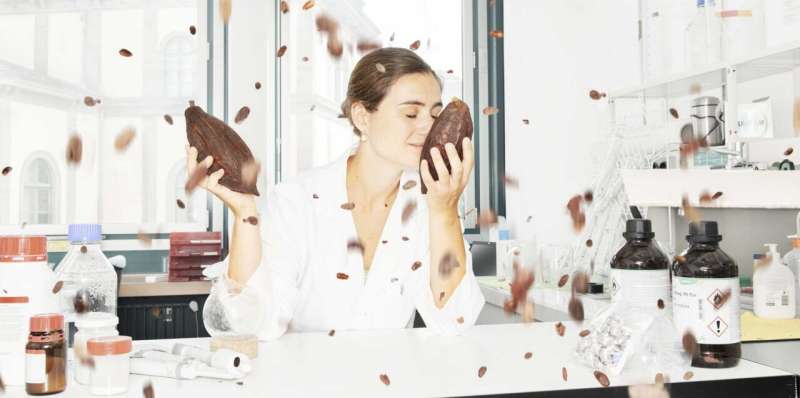This article has been reviewed according to Science X's editorial process and policies. Editors have highlighted the following attributes while ensuring the content's credibility:
fact-checked
trusted source
proofread
Researcher investigates cacao 'fingerprints' for production of better chocolate

Using a new analytical method, ETH Zurich doctoral student Julie Lestang aims to determine the chemical profile of cacao beans reliably and quickly. This forms the basis for controlled fermentation—and high-quality chocolate.
From her own experience, Julie Lestang knows what happens when undesirable microorganisms penetrate the cacao fermentation process. Before coming to Zurich in November 2021, she worked for two years in Ivory Coast for the cacao division of an international food company. "Mold is a big problem," Lestang says. "Sometimes, a ship's entire cacao cargo has to be scrapped because it arrives moldy."
Mold not only affects the taste of the cocoa, but it can also be a health hazard, as the fungi produce dangerous mycotoxins. "That's why, in our research project, we're looking for microorganisms that inhibit fungal attack and lead to controlled and optimal fermentation of cacao beans," Lestang explains.
The French agronomist is currently pursuing a doctorate in the Laboratory of Food Biotechnology at ETH Zurich's Department of Health Sciences and Technology. When she was younger, she first wanted to be a chocolatier after visiting a chocolate factory with her school. She ultimately chose another path, but during her agronomy studies in Montpellier, France, where she specialized in food production in Mediterranean and tropical countries, Lestang's interest in the cacao fruit grew.
Improved control of fermentation
By the time a bar of chocolate reaches the grocery store shelf, the cacao it contains has not only traveled a long way, but has also undergone a certain amount of processing. A core part of this is fermentation, a natural process that begins as soon as the green to reddish-yellow cacao fruit is harvested, broken open, and the beans laid out in wooden boxes to dry.
Naturally occurring microorganisms found on tools, on the banana leaves used to cover the beans, or on the farmers' hands break down the sugars in the pulp that surrounds the beans. The process heats up the beans and makes them more acidic, destroying their cells. "This prevents the seeds from germinating; otherwise, you'd soon have lots of little cacao trees," Lestang says with a laugh. During fermentation is also when the beans acquire their cocoa-brown color and the bitter, earthy taste so typical of unsweetened chocolate.
The quality and taste of the cacao depend largely on which microorganisms are involved in this fermentation process. "If we treat the cacao beans with the right mix of microorganisms at the start of fermentation, we reduce health risks, quality loss and food waste," Lestang explains.
Food technologists use yeasts and lactic acid bacteria as fungus-inhibiting fermentation starters. However, not all cacao beans react the same way to the microorganisms, because the beans' chemical profiles and properties vary depending on the variety of cacao and where it was cultivated. That's why in her project, Lestang is developing a method to determine the chemical fingerprint of cacao beans. Her work is making clear which starters best protect a bean from fungal attack.
For her analysis, Lestang uses rapid evaporative ionization mass spectroscopy (REIMS), a method primarily used for microbiological tests in medicine; it is rarely used in the food sector. "The advantage of REIMS is that both sample preparation and evaluation are much less involved and time‑consuming than conventional test methods."
To prep the cacao beans for analysis, Lestang grinds them up and adds water and methanol. She spreads the resulting suspension onto a metal plate and then burns it with a kind of soldering iron. The resulting gases are broken down by a spectrometer to reveal their chemical composition. Finally, a diagram depicts the "fingerprint" of the cacao bean.
Validation in cocoa-producing countries
Lestang is collaborating closely on the project with the Food Biotechnology Research Group at the Zurich University of Applied Sciences (ZHAW). The latter has been conducting research together with industry partners for more than ten years to improve the cacao processing method. In addition to a collection of more than 13,000 microorganisms, the ZHAW researchers have established a partner network with producers in several countries in Central and South America.
Early on in the project, a former doctoral student isolated nearly 800 microorganisms from the fermentation of cacao beans in Honduras and tested them for later use. Four candidates turned out to be particularly promising. Lestang can draw on this experience and network to test her laboratory findings in the field.
An initial batch of fermentation starters are currently being tested in the partner countries on samples of 20 to 50 kilograms of cacao beans. Next autumn, Lestang will travel to Ecuador to do further testing. If it turns out that mass spectroscopy analysis is suitable for developing the right kind of starters quickly and reliably, Lestang is convinced that this method could become increasingly popular in the food sector—including, for example, in coffee processing.
As for Lestang herself, she wants to continue working with cacao after completing her doctorate. Recently, she trained as a chocolate taster at an institute in the U.K.—"in my spare time," she emphasizes. "And this experience only increased my fascination with this fruit and its processing."
Provided by ETH Zurich





















